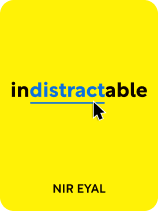

This article is an excerpt from the Shortform book guide to "Indistractable" by Nir Eyal. Shortform has the world's best summaries and analyses of books you should be reading.
Like this article? Sign up for a free trial here .
Do you struggle with workplace distractions? What are the two worst external triggers for distraction and stress? Is it possible to control the environment around you and cut them out?
According to Nir Eyal, the two biggest external triggers for distraction at work are other people and email. It may be impossible to cut them out of your workday, but it is possible to reduce distraction from communication by setting boundaries.
Here is what Nir Eyal has to say about reducing distractions from communication at work.
Cut Out External Triggers
The third element of becoming indistractable is reducing the external triggers in your life. While internal triggers are frequent drivers of distraction, external triggers constantly invade our lives with beeps, pop-up notifications, vibrations, alarms, and so on. They tempt you with an escape from any internal discomfort you may be feeling.
It’s vital that you get a handle on the external triggers around you because they don’t just interrupt you for a moment—they can derail your workflow for an extended period. Research shows that when people are interrupted during a task—to answer a message or check their email, for example—they’ll try to compensate when they return to the task by working faster, but with higher stress levels.
Unfortunately, the answer isn’t so easy as refusing to respond to incoming emails or turning your phone facedown.
- One study showed that simply receiving a notification is just as distracting as responding to a message or call.
- Furthermore, the mere presence of your phone—even if you’re not looking at it—strains your attention because a portion of your mental energy is allocated to ignoring your phone.
Sort Your External Triggers
Deciding how to handle external triggers can be complicated because while most are distractions, some can help you build traction.
- For example, you may have alarms that keep you on track with your timeboxed schedule, health apps that send reminders to drink water and stretch, and so on.
It’s up to you to decide which of your device’s triggers are useful and which are distracting. Give each trigger an honest assessment by asking yourself: Does this trigger benefit me, or do I benefit it?
There are two types of external triggers you’ll have to adjust in your life—triggers that come from a lack of boundaries around your communication with others, and triggers that stem from the technology you use every day. In this article, we’ll explore ways to reduce distraction from communication without boundaries.
Trigger #1: Other People
Other people are some of the most pervasive distractions in your workplace. This problem is especially present in modern office environments, as 70% of American offices have adopted “open floor plans.” This means that employees don’t have closed-off workspaces that they can retreat to for deep focus. Instead, they’re in the middle of a sea of triggers—they can see what their colleagues are doing, overhear conversations, see who’s coming in and out, smell the donuts in the break room, and so on. These constant distractions slow down your work, force you to catch up by working faster with more stress, and decrease your overall satisfaction.
Send the Right Message
You can’t control everything that’s happening around you in your work environment, but you can control your messaging. Create an obvious visual cue that tells other people that you’re not available for interruption. This can take any form that makes sense to you:
- A large piece of cardstock on the top of your computer monitor with a message such as, “I’m focusing right now, please come back later.”
- Taping a sign to the back of your chair that says, “Please don’t interrupt me right now. I’ll be available at 3.”
- A designated hat or pair of headphones that signify deep focus time
It’s important to talk to everyone in your workspace—whether you’re in an office environment or working from home—about your system, for three reasons.
- You ensure that they understand your commitment to being indistractable and don’t interrupt you.
- They’re forced to think about their behaviors, and they’ll be more aware of interrupting you and others in the future.
- They may learn from you and make their own signal to show that they need time without interruptions.
Trigger #2: Email
Checking your email and responding to messages may feel productive, but it’s a huge source of distraction in your life. The average employee receives 100+ emails per day—that means that if you spend just two minutes reading and replying to each message, you’re spending nearly three and a half hours per day on email. Compounding email’s distracting power is the fact that, on average, it takes you 64 seconds to refocus on your work after checking your email. Every time your phone dings with an email alert, you lose at least a minute.
The total time you spend on email is made up of a) how much time you spend checking your inbox and b) how much time you spend responding to messages. By reducing the time you spend on these activities, you can reclaim hours of your day.
Spend Less Time Checking Your Inbox
You may rationally know that checking your email constantly is a waste of your time and a serious interruption of your focus—but most of us just can’t stop. This is due to two elements of human psychology.
1) Your inbox offers random rewards. When you can’t predict when an action will reward you, the action becomes exciting or tempting. This is the same factor that makes gambling so addictive—you never know if the next $20 you bet will reward you with a jackpot. Your inbox delivers random rewards in the same fashion. Sometimes it contains useless or boring messages, other times an important message from your boss, a piece of good news, or a message from a friend. You can’t stop checking, just in case the next click delivers a reward.
- Make your inbox as predictable as possible to make it less tempting. Unsubscribe from any emails that aren’t useful any longer, such as newsletters or retail promos. You can do this in a dedicated hour, or streamline your inbox over a matter of weeks by unsubscribing from unwanted emails as they come in.
2) You’re inclined to reciprocate communication. Humans are social creatures that mirror the actions of others—when someone smiles at you, you’ll smile back. While this reciprocity cycle is fine in person, helping you establish social connections, it becomes a problem online. When someone sends you a message, you’re naturally inclined to respond right away. Unfortunately, this prompts the other person to respond right away, which triggers you to respond—it becomes a stressful, fast-paced cycle. By finding ways to send fewer emails, you can break the cycle of reciprocity and ensure that you’ll receive fewer emails. There are two ways to accomplish this.
- Create office hours for non-urgent matters. Instead of responding to someone’s question right away, you might say, “I have some time open on Wednesday and Friday from 2-3. If you’d still like to talk about this at that time, feel free to stop by my desk!” This prevents you and the other person from replying back and forth multiple times and creates a “cooling off” period for the question—often, the sender will find a solution on their own, or the problem resolves itself or becomes irrelevant.
- Manually slow down reciprocity. Most people send emails immediately after writing them. When you and another person are keeping up a fast-paced back-and-forth, the matter can feel deserving of your immediate attention—even when it’s not urgent at all. Use your email service’s “delayed delivery” tool to send your emails a few hours or days after you write them. This clears the email off your plate but doesn’t prompt a quick reply from the other person. Additionally, this service can prevent you from getting replies when you don’t want them—for example, if you answer emails on Friday afternoons but don’t want replies over the weekend, you can delay their delivery until Monday morning.

———End of Preview———
Like what you just read? Read the rest of the world's best book summary and analysis of Nir Eyal's "Indistractable" at Shortform .
Here's what you'll find in our full Indistractable summary :
- How to become indistractable in a world full of distractions
- Why your schedule should be based on your values instead of tasks
- How to start driving your life instead of letting its distractions drive you






